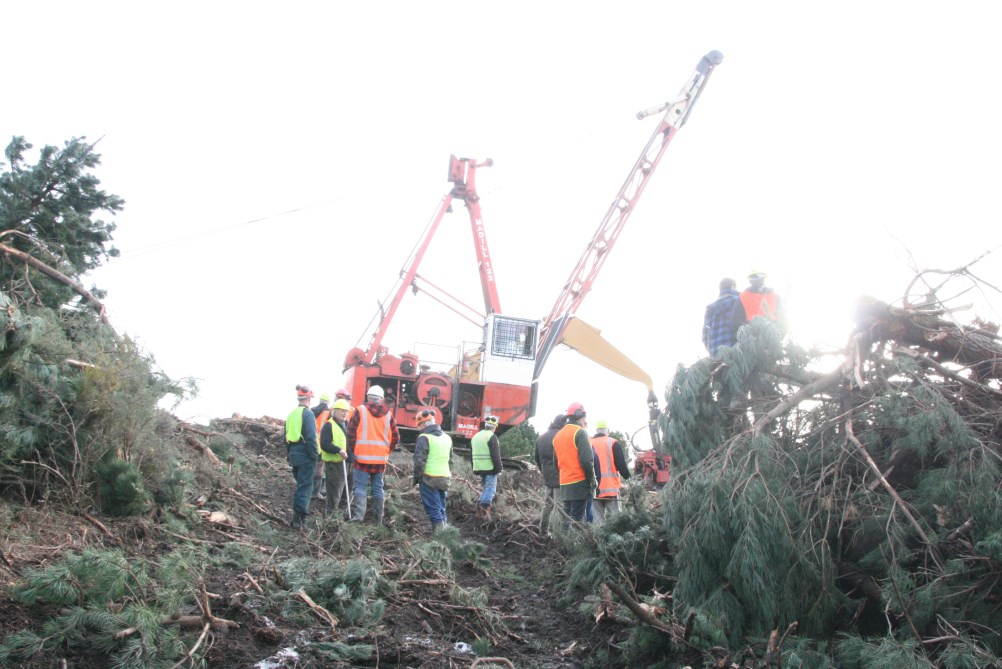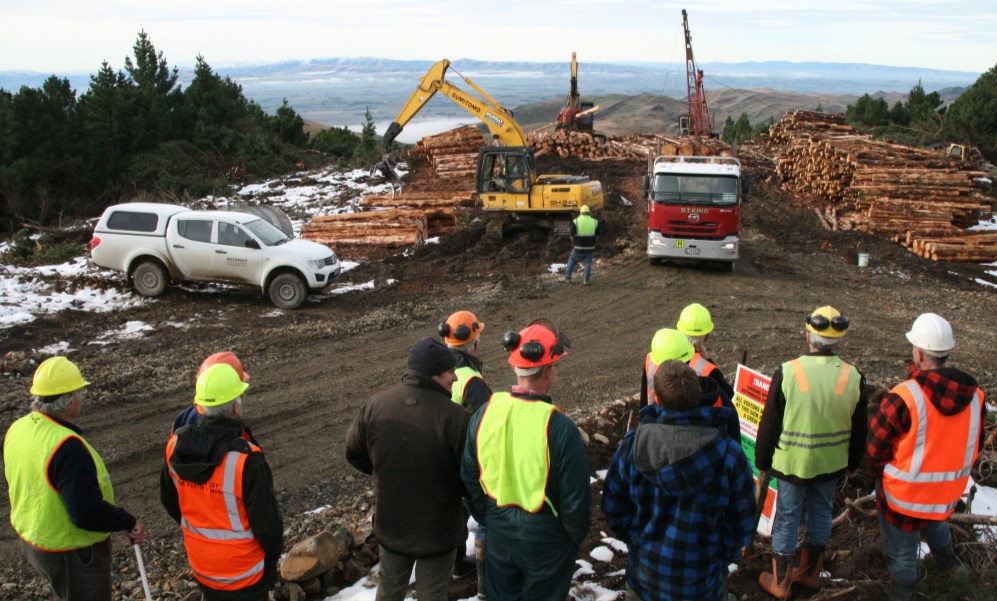NZFFA Member Blogs
Member Blogs
-
Brian Cox's Blog
-
Chris Perley's Blog
-
Dean Satchell's blog
-
Denis Hocking's blog
-
Dennis Neilson's blog
-
Eric Cairn's Blog
-
Grant Hunters blog
-
Hamish Levack's Blog
-
Howard Moore's blog
-
Ian Brennon's blog
-
Ian Brown's Blog
-
Jeff Tombleson's blog
-
John Ellegard's blog
-
John Fairweather's blog
-
John Purey-Cust Ponders
-
Murray Grant's Blog
-
Nick Ledgard's Blog
-
Rik Deaton's Blog
-
Roger May's Blog
-
School of Forestry blog
-
Shem Kerr's blog
-
Vaughan Kearns blog
-
Wink Sutton's Blog
Recent blogs:
Bare Hill's Hauler logging
John Purey-Cust PondersWednesday, August 13, 2014
A little while ago I went on a field trip to look at a logging operation at Bare Hill, a high and miserable pine plantation on the top of the Hokonuis. Bare Hill itself peaks at 750m altitude, a fog-bound waterlogged landscape whose upper slopes are a mixture of dense broom and sporadic radiata and muricata pine, falling down to the north into the upper Otamita catch-ment.
The lower planting level on the north face is about 500m, so the whole stand is, to me, above the upper altitude for sensible radiata planting in Southland, and Bare Hill shows it. But that is another story.
I hadn’t seen a hauler logging operation for some time as with the advent of log skidders and then various kinds of digger they largely went out of fashion in these parts, as had horses before them.
Early haulers, huge unwieldy machines on a sledge and capable of handling large heavy native logs, liked to be perched on a ridge top with a downhill view in as many di-rections as possible. The endless dragging of large tree-length logs broke up the slash and made an ideal seed bed for regenera-tion, a mixed blessing and a tree breeder’s curse..
Skidders, higher production ground hauling machines with a high mud and mess-making capacity are slowly evolving towards cleaner and more nimble diggers.
The Bare Hill hauler had evolved too, to a small compact and maneuverable machine pulling tree lengths, in this case small, short and mostly malformed, off the cutover. Log making was done on the hauler landing. There was some discussion on the state of the cutover, which, from a distance, looked as if replanting (with Douglas fir) should be possible without much further attention.
Hauler logging is more expensive than ground hauling, conventionally by a third if I remember right, and that argument was raised here, that cost ruled over site disturbance and that ground hauling machinery (which would have been predominantly skidders) should have been used.
The argument didn’t get very far because the two sites in question were in no way comparable, but another issue raises its head – regulation. The Regional Council is proposing new standards for high country development, which seem to have been well received. That can’t be for farming alone and it isn’t very bright to think that logging will be ignored.
Expect more small haulers and deduct any extra cost from the stumpage, as it should be anyway.


Radiata pine wood quality
Denis Hocking's blogFriday, June 20, 2014
Radiata pine may be an easy and productive timber species for us to grow, but it has long been recognised that the timber does have a number of quality problems. These have been compounded by genetic improvement programmes that focused almost entirely on growth rate and tree form, (hence GF, Growth & Form). There was a reason for this - it allowed growers to be rewarded with bigger volumes and better, visually assessed log grades. However it has left us with a forest estate with questionable, and perhaps even more important, very variable, wood quality.
The Wood Quality Initiative was launched to tackle these problems in 2003, and the work continues under the alternative monicker of Solid Wood Innovation. Recently a Scion workshop was held in both Christchurch and Rotorua to discuss progress and continuing problems. The basic wood characteristics of radiata pine have been understood for over 50 years, particularly the problems of the juvenile core where the first 10-12m growth rings are lower wood density, less stiff and potentially unstable because of spiral grain.
To date most work has been done on sonic testing for stiffness in structural timber, which allows segregation of timber at any stage from the plantation through to the back of the saw mill. The tech- nology is now being used quite widely, but I have yet to see it on any skid site near here. We also need to think about the implications of further log segregation for smaller, farm forestry scale, harvest volumes. Stiffness correlates with both wood density and the microfibrillar angle of the cellulose in the cell wall. What the scientists are still struggling with is technology to predict timber stability after drying.
If you want to grow structural timber you really need a lower fertility, warmer site, (Northland not Southland) with higher stocking rates and longer rotations. But even at best our radiata pine is not a particularly good structural timber, both the Aussies and the Chileans produce better, stiffer radiata pine and European pine is making increasing inroads into the Australian market with better stiffness and stability. So many experts still favour clear wood and appearance grades as our best value adding option. Our radiata pine generally does have good machining, finishing and appearance characteristics.
With clear wood density and stiffness are not major issues, though apparently some customers do specify particularly densi- ties. Tenon, our biggest clear wood processor presented an excellent paper, identifying their wood quality problems. There are two biggies for them – resin pockets and intra-ring checking. Resin is strongly affected by environment with various factors being blamed, such as drought stress, wind and boron deficien- cy. Problems can be predicted from checking the ends of logs and if it is a problem in your forests don’t expect the clear wood processors to come calling. Intra-ring checking can also be assessed by looking for “green” checks in log ends, though they often resort to wood samples or trial loads from suspect sources.
Age is one factor here, they do not take logs younger than 25 years, but there is some confidence that this problem will reduce or even disappear in the future after the culling of some suscepti- ble genetic material.
The lesser problems for Tenon and their clear wood include stability, resinous heartwood and some other appearance issues such as needle fleck and conspicuous resin canals.
One interesting message was that effectively we are currently exporting much of our wood quality problem by sending the majority of the problematic logs to China for processing. Long time forestry consultant and commentator Dennis Neilson gave a mind boggling insight into the Chinese scene. China has made a huge, (though huge is a serious understatement), investment in soft- wood milling, and indeed is still investing. It is not the latest, most automated technology but rather multiple, modern saw-sets under a single roof. With markets for everything that comes out of even the roughest of logs, they can make much better use of these poorer quality logs than our domestic sawmillers. One local sawmiller gave the flip-side of this situation when he described China as the market of last resort for sawn timber. Not all proces- sors were quite as negative, but point was made. Interestingly though, Chinese efforts to move radiata pine “up-market” have had mixed results with some notable failures.
So where to with radiata pine? I am not sure, but the only clear message at the end of the workshop was the need for more research. Now where have I heard that before?
Disclaimer: Personal views expressed in this blog are those of the writers and do not necessarily represent those of the NZ Farm Forestry Association.

 Farm Forestry New Zealand
Farm Forestry New Zealand